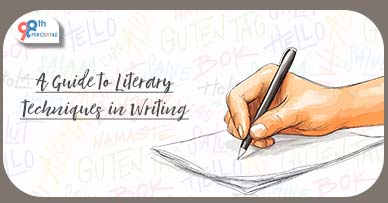Literary techniques are tools that writers use to make their words more engaging, expressive, and memorable. Metaphors to simile to alliterations, if you want to know about literary techniques, you have googled your way to the right place.
Writers employ literary strategies to enhance the expressiveness, memorability, and engagement of their words. These strategies help make writing come to life, from metaphors that conjure up strong images to repetition that highlights concepts. Knowing literary devices can enhance storytelling and increase comprehension, whether you're reading a book or writing an essay.
Access FREE English Practice Worksheets!
Literary Techniques Examples
Here are five essential writing strategies that enhance writing's complexity and originality.
1. Metaphor: Establishing Relationships
A metaphor gives a subject a greater meaning by comparing two unrelated items.
"Her voice was music to his ears," for instance. Her voice is described with a good, poetic image added by the metaphor.
2. Simile: Using Comparison to Provide Clarity
Similes clarify descriptions by comparing two items with the terms "like" or "as."
"The sky was as dark as ink," for instance. Readers can better visualize the darkness's intensity thanks to the analogy.
3. Alliteration: Creating Flow and Rhythm
Alliteration adds rhythm and memorability to words by repeating the same consonant sound at the beginning of adjacent words.
"Peter Piper picked a peck of pickled peppers," for instance. A fun tone and musicality are added by this repetition.
4. Hyperbole: Stressing Strong Emotions
Exaggeration is used in hyperbole to highlight a statement or feeling, frequently in a lighthearted manner.
"I've told you a million times," for instance. The speaker's dissatisfaction is emphasized by this exaggeration.
5. Imagery: Using Words to Paint Pictures
Using sensory-engaging language to help readers imagine scenes is known as imagery.
For instance: "The air was filled with the fresh aroma of pine." Readers are given a rich sensory experience as a result.
In conclusion, Literary devices or literary techniques provide writing depth and richness, which increases the interest and memorability of stories. Authors create an immersive experience through the use of imagery, similes, alliteration, metaphors, and hyperbole. Knowing these strategies encourages more expressive, impactful writing in addition to enhancing understanding.
FAQs (Frequently Asked Questions)
Q.1: What are literary techniques?
Ans- Writers employ literary strategies to improve their work by giving their words more nuance, passion, and significance.
Q.2: What are the types of literary techniques?
Ans- Metaphor, simile, hyperbole, personification, and alliteration are examples of common types.
Q.3: The sun shone on the dew-covered grass like a shining crystal. Which literary technique is used here?
Ans- It is a metaphor.
Q.4: Why are literary techniques important?
Ans- They enhance the writing's emotional power, clarity, and imagery, which makes it more captivating and memorable.
Q.5: Give an example of hyperbole.
Ans- "I could eat a horse because I'm so hungry."
Start Learning English – Get FREE Worksheets!

 Students/Staff
Students/Staff Parents
Parents ElevatEd
ElevatEd














